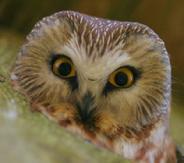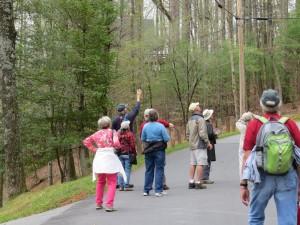Audubon North Carolina has 10 amazing chapters across the state who help put a local focus on bird preservation and conservation issues. In this special blog series, we’ll focus on a chapter each month to learn more about their history, what they are working on, and to increase the statewide understanding of special ecosystems and habitats. Each month will include a series of posts about each chapter including a post from our biologists that will share a unique research project that is happening in the chapter’s geographic footprint.
This month, we get to know the High Country Audubon Society.
History: With a small population base and a large territory, it was often difficult to find individuals to share in the joy of birding. What better way to get our area birders together than to form a local Audubon Chapter? That was the intent of creating the High Country Audubon Society (HCAS) in 2006. The new chapter has gone on to fill a gap in coverage in the northwest corner of the state taking in Alleghany, Ashe, Avery, Watauga and Wilkes counties.
Through the ensuing years, with the help of many dedicated volunteers, the chapter has succeeded in becoming a magnet for experienced bird-watchers, and it has become a source of information for beginning birders as well.
As the chapter evolved, so has its mission of being a social group. It has turned into a community that is not only connecting bird-watchers, but also one that is working together to protect and support avian life. Presently, the chapter’s mission is to encourage beginning birders and experts alike to engage in conservation, education and research for the benefit of the birds of western North Carolina.
How Many Members: Our chapter has remained fairly small over the years. There are approximately 60 dues-paying members, with many of them spending the summer months in the High Country, returning to warmer areas for the winter.
Annual Activities: Chapter members have organized a field trip each year to the coast in either December or January to see birds when the High Country has very few. While the variety of birds in the mountains is to be envied, there is nothing like a trip to the flatlands across the state in search of some new species. Typically 6 to 10 members spend three days viewing the geese and swans at Lake Mattamuskeet, search for purple sandpipers at the groin and scan the ponds at Pea Island. Even without the occasional rarities, the species list during this trip usually contains enough birds that are not found in the mountains, making the trip a memorable event.
One of the first continuing projects High Country Audubon was the adoption of the Wilson Creek Important Bird Area. This beautiful river drainage is located on the south slopes of Grandfather Mountain and includes the Wilson Creek Wild and Scenic River. This year marks the fifth anniversary that volunteers from HCAS have been doing point counts at approximately 30 different locations in this Important Bird Area.
Special Project(s) We Are Working On: Unfortunately our Death to Garlic Mustard campaign has no end in sight. Three years ago, during the weekly bird walks at Valle Crucis Community Park, some of our chapter members noticed that the non-native, invasive Garlic Mustard was abundant in several areas of the park. We teamed up with volunteers from Blue Ridge Conservancy to pull about 20 bags of the plant during our first year. The amount we have collected since has decreased. However, in 2014 we still managed to find enough Garlic Mustard to fill three garbage bags. In the meantime, we have added the Meat Camp Environmental Studies Area to our list of clean up locations. After we clean up these areas, who knows where we will work on next?
In 2012, HCAS initiated the Sue Wells Research Grant program. Applications are accepted from high school or university students conducting research activities on birds of the High Country. Cash awards of $500 - $1000 can be used for travel expenses, equipment or other research related needs. Past recipients have been Jessica Krippel of Western Carolina University, and Morgan Harris and Angie Langevin of Appalachian State. Their work has ranged from competition between bird species for reproductive opportunities to the impact that birds have on their local environment. In 2015 we awarded the grant to Kristen Content, a biology graduate student at Appalachian State University, to support her research on how avian stress hormones affect the behavior and reproductive success of Tree Swallows.
This year we created a birding scholarship to help young birds attend a Carolina Bird Club meeting in 2016. We’ve noticed that at these meetings there are few people without gray hair and since we think costs might be preventing college-aged birders from attending we have decided to provide funds to help them attend. The person selected must be 24 years old or younger and live in the five-county HCAS territory. Funds will be provided to pay for registration, hotel, and some meals and gasoline.
What Birds to See in Your Area: With a variety of habitats spread out over more than 5,000 feet of elevation change, we are pleased to have a wide variety of birds. At higher elevations, High Country is home to Red Crossbills, Red-breasted Nuthatches, Pine Siskins, Magnolia Warblers and others. At lower elevations, we have lakes such as W. Kerr Scott Reservoir and Lake Hickory that are home to many species of waterfowl during the fall and spring migration. This often includes birds that are seldom seen away from the coast. And we cannot forget to mention the bird we have featured as our Chapter’s logo, the Northern Saw-whet Owl!
Where Are the Best Birding Spots in our Area: Several spots in the High Country are included in North Carolina’s Birding Trail. One of the most accessible spots, Valle Crucis Community Park, offers weekly bird walks every Wednesday morning during spring until fall. Do not let the playground and soccer fields scare you off. With 138 bird species recorded, it’s a great place to enjoy an array of birds.
The Blue Ridge Parkway offers several sites with hiking trails that offer a get-away from the noise and traffic of everyday life and allow you to enjoy nature in the mountains. Bass Lake and Price Lake near Blowing Rock provide homes to families of Wood Ducks and birds that pass through in the spring and the fall. Grandfather Mountain and Elk Knob State Parks have miles of trails through high elevation forests that provide opportunities to find birds that only live in North Carolina’s mountains.
Join This Chapter: Dues for an annual membership in High Country Audubon Society is just $10 per year. Click here for more information or to join our chapter.





